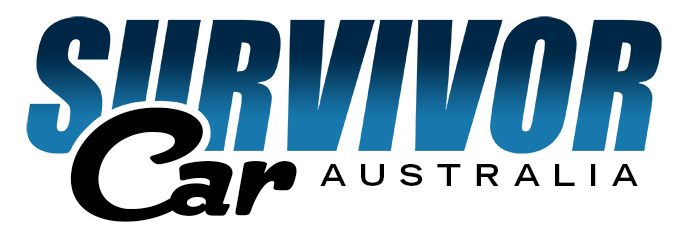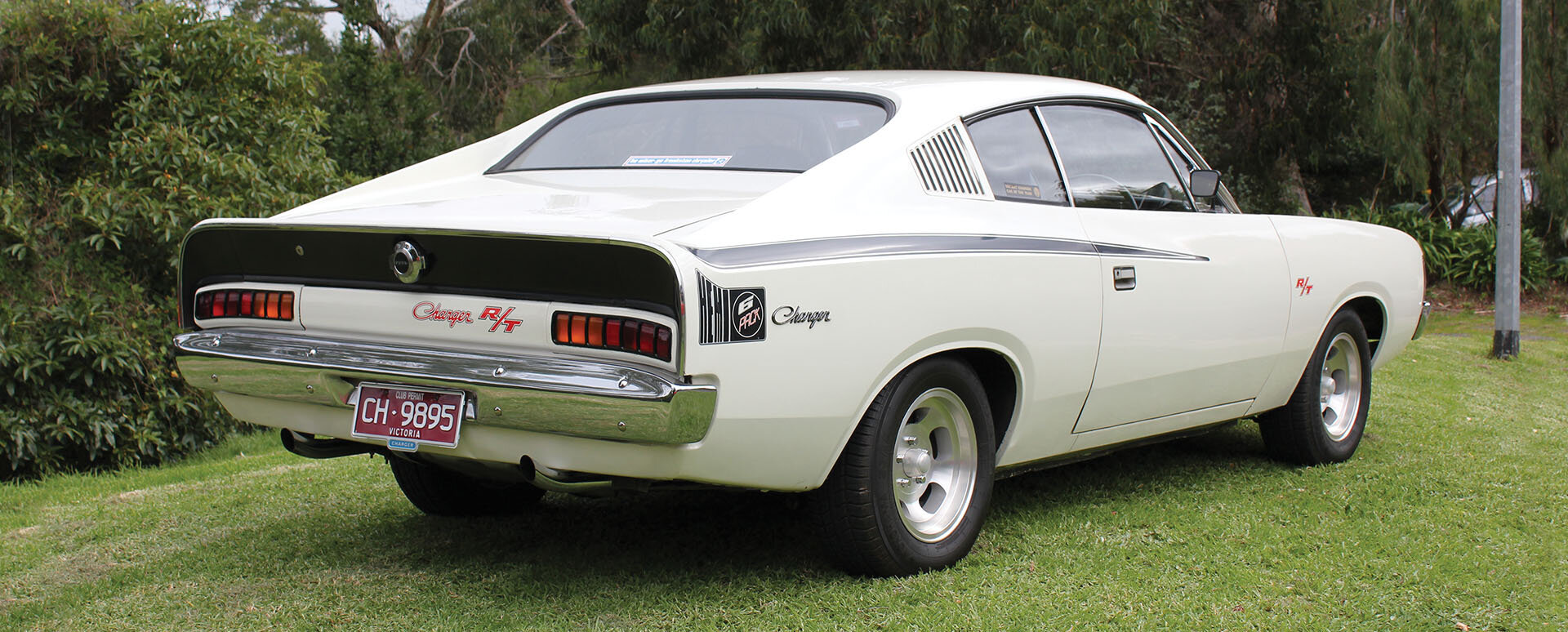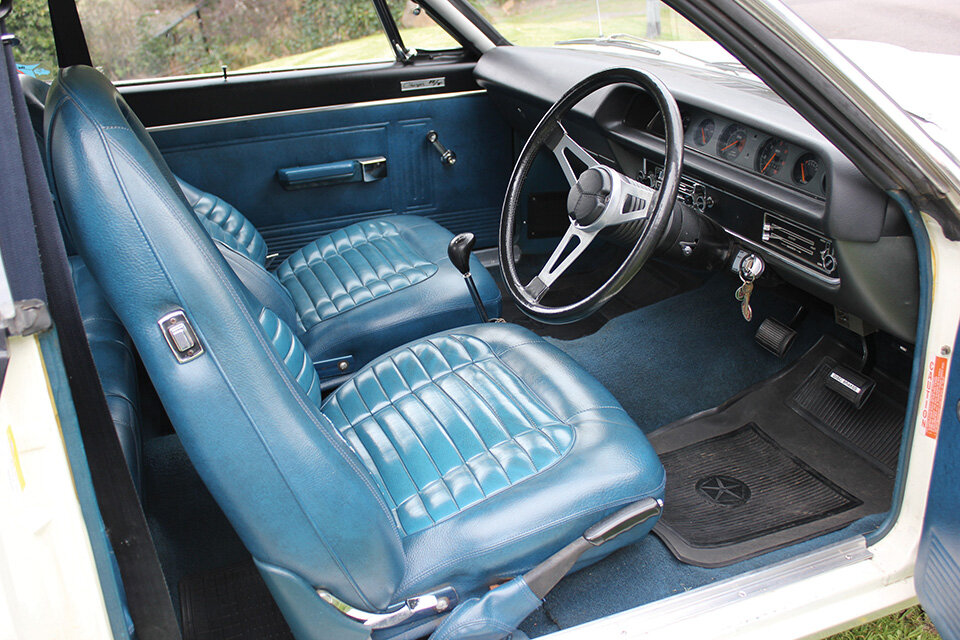urban myth
Born through one family’s eccentric attraction to white cars with blue cabins, this well cared for E49 was for many years unaccounted for. Believed by devoted enthusiasts as a motoring myth, it existed on paper, but none had seen or heard of it. That was until an ‘out of the blue’ appearance at a local car show on the Mornington Peninsula back in 2002. After many years cruising under the radar, this E49 charged into the limelight causing quite a stir.
FROM SURVIVOR CAR AUSTRALIA MAGAZINE - ISSUE #3
Very few Chargers had ‘delete stripes’.
The Valiant Charger was an incredible success for Chrysler Australia. In its first year it won the coveted Wheels Car of the Year award for 1971, it also won the hearts of a great many Aussie and Kiwi car buyers. There was a range of models with various options available to suit all tastes and budgets.
Starting with a base model known simply as Charger, the line up also included the Charger XL, the 770 (essentially built to Regal levels of trim and comfort) and then to top it off came the new ‘hero car’, the R/T. Aimed squarely at competing with Ford’s GT Falcon, Holden’s Monaro GTS and Torana GTR-XU1, the R/Ts were designed to take on the opposition both on the showroom floor, and on the racetracks of Australia and New Zealand. Incidentally, the acronym R/T was derived from the cars American cousins and stood for ‘Road & Track’. It was used on a range of Dodge performance cars including the popular R/T Charger and R/T Challenger.
The R/T also came in several levels, the 265cid ‘High Performance’ six-cylinder 2-Barrel base model was the entry point, followed by the E37 triple Weber (a detuned ‘street six-pack’) and topped off with the full-house ready to race 280bhp E38, at what seems now a bargain price of $3,975.
White Hot 6 pack
Following on from the E38, in 1972 the Charger reached its final performance incarnation as the brutish E49, at only $345 more than an E38; it was further tuned to push out 302bhp and now mated to the long awaited 4-speed manual. Only 148 R/T E49s were built, making them pretty rare to start with, however, amongst these there were a number of even rarer cars built to special order. One such car is the incredibly well preserved Alpine White Charger gracing these pages. Apart from the rare colour, it is also the only R/T E49 fitted with a blue interior.
The car was bought new by Steve Watkins from the dealer ‘Frankston Chrysler’ in the spring of 1972. And although white R/Ts were not a common choice, for Steve, as you will soon discover, it seemed an obvious one. You see, Steve’s father was Fred Watkins, of ‘Watkins the Butchers’ a successful Butcher who also raised his own cattle on his Mornington property named Hillcrest. In addition, with the Mornington racecourse located nearby, Fred had also adapted himself to racehorse breeding and training, all of these accomplishments allowed him to indulge in his passion for motorcars.
Steve’s father had an eclectic collection of cars over the years including; a 1956 Rolls Royce Silver Cloud (now an integral part of the Fox car collection); a couple of Ferraris; a 365 GT and 330 GTC, a Mercedes 300D and the first Aston Martin DBS delivered to Australia. All of these cars, with a touch of eccentricity, had been factory painted white, with most sporting blue interiors.
That thing got a Hemi?
So this goes some way to explain Steve’s feeling towards white cars, even his first, a 1954 Morris Minor he had at age 18 had been white. It was when in his mid-twenties, also working as a horse trainer and breeder, Steve found himself attracted to Chrysler’s clever ad campaign and after seeing a few cruising down the road his decision to buy one was cemented.
“I liked the romance of the vehicle” Steve later said, so he made the trip to Frankston Chrysler and ordered his new car. What he got was a November 1972 build E49 in Alpine white, paint code WA (BERG4301, a Berger colour), A87 Track pack (minus big tank) A95 Interior dress-up pack, D56 3.50:1 LSD, D20 4-speed manual with B1 blue vinyl trim, as noted previously, this is the only E49 with this particular feature. Stamped on the inner fender next to the body number is ‘SOA’ which denotes this vehicle as a ‘Special Order Accepted’. In this case, SOA 245 relates to factory acceptance of the customer order requesting the delete fender stripes and G60 front quarter vent windows. Many Charger fanatics have mistaken the SOA numbers on this car to mean that it was special ordered with a 245 Hemi, when it is in fact just a numbering coincidence.
Barely 9,000 miles were clocked up by Steve during his ownership, despite it being his daily driver for much of the 1970s and having done a few family holidays. Steve recalls one trip in particular; “I remember one year early on we took the Charger on a family holiday up to Mount Buller. We got there around 5pm and there were no vacancies at the motels so we decided to drive through to Whitfield, some 100 kilometres away. It was the middle of winter and we took a short cut which ended up being a dirt track suitable for logging trucks only. The Charger didn’t like it much but we made it through eventually after a few harrowing hours”.
Steve recalls his father Fred, only ever driving the Charger once, “We had a long bitumen driveway and he gave it a bootful heading out. When he got near the top he found the non-power assisted brakes a little hairy compared to his other cars, and left skid marks right out onto the road!” He vowed never to drive it again. For the record, there were only four E49s that were fitted with B51 power assisted brake option and this car was not one of them!
Fortunate family friend
The Charger was the Watkins family car back in the ’70s.
With a growing family, the Charger was getting less and less use, eventually it was parked up and left in one of the five garages on the Mornington property. Several other cars came and went during this time including a Volvo P1800 and a Porsche, all white of course! In the early 1980s a good friend of the family Colin Windebank; heard via the grape vine that the car may be up for sale. Colin was based in Darwin from 1973 to 1986 and when he got the news he did a deal over the phone almost immediately. He arranged for the car to stay at the ‘Hillcrest’ property for the time being.
On his return in 1986, Colin had the car given its second registration plate. Noticing that ‘E’ was the letter designation at the time, while at Vic Roads he cheekily asked if he could have EEE-049 he was pleasantly surprised when they actually said yes! Colin really started to use the car now, rotating the odometer around to 50,000 miles. It was only then that it needed its second set of tyres!
Coming out in 2002
Colin never took the Charger to any car shows himself, however his daughter did take it once to a show around Mornington, no doubt when Colin was out exercising his 1984 Trans Am instead! It was at this show, where a number of Charger devotees were suddenly made aware of this significant one of a kind Charger. To those familiar with Chrysler’s official production records, this car had been built on paper, but none of them had ever seen or heard of its actual existence until now; it was presumed to either have suffered an untimely fate or have been an error in Chrysler Australia’s records and conceivably, never have been built at all. It was at this event that the current owner first set eyes on the urban myth, the white hot E49 six-pack with blue vinyl trim.
In 2004, Colin decided to on-sell the car, and so took it to his usual workshop, Valiance in South Melbourne to organise a pre-sale roadworthy. They in turn contacted Paul Norris from ELKO Performance, a Chrysler parts specialist who had expressed interest in the car previously. At the time his hands were tied, so he in turn mentioned it to fellow Chrysler enthusiast Des Seaton. As it turns out, Des had harboured the desire to purchase the car since seeing it in the flesh at the car show, and despite the sale price being a bit over current market value at the time, he did not hesitate to make a deal.
That deal, with the increase in Charger values, and a new found market-appreciation for good unrestored Survivor muscle cars, was one we are sure he never regretted!
Des has had a long and close affiliation with Chryslers as he worked at Ferntree Gully Chrysler in the 1970s and still has his ‘Service Management’ training certificate from 1978 as a reminder. He knows how to look after and maintain these cars, and he appreciates what he has. By limiting the Charger’s use, occasionally taking it to shows for other ‘Chryslerphiles’ to enjoy, he plans on keeping it just the way it is.
Now showing a mere 88,147 miles, Des’s car is still looking exceptional, it has never been painted or damaged. Des relates this to the fact that it has always been undercover and looked after by enthusiasts. The distinctive blue interior is a welcome change to the standard black (X1) that became the norm for many muscle cars, and it compliments the white exterior nicely. Only a few minor tears and splits on the driver’s seat bolster detract from the otherwise near factory fresh interior. The rare factory radio-cassette is still in place, as is the original gear knob, three spoke sports wheel and R/T dash cluster.
The body is arrow straight and rust-free (an ailment that sadly affected the majority of Chargers over time) and the white seems to show off the sharp lines more distinctly by being less distracting than some of its brighter siblings (think: Magenta, Vitamin C, Hot Mustard and the likes). The factory painted stripes gracing the top of its flanks accentuate the sharp hip line which leads into a curve up and across to create the distinctive duck tail spoiler.
The deleted vertical guard stripe seems to make the car look longer and lower in profile and the blacked out tail panel helps give a wide tough stance from the rear. It is only the chips, cracks and fading on the original stripes and ‘Hemi 6 Pack’ stickers along with the myriad of small stone-chips on its paint that show the truth of its unrestored condition. A real Survivor with a few minor battle scars.
All in all, there were four white E49s built, sadly one of which was written off in the 1980s. One, body #1294 went to New Zealand and was the only Arctic white car built. Two others, #1231 and this one; body #1254 were sold in Victoria, another, #1208 went to New South Wales.
In the sensitively detailed engine bay things are as factory, albeit tarnished with age and use. The usual rust spots such as the plenum covers and battery tray are clean, and the stickers, though dried out wrinkled and peeling, are all in place. The original six pack carburettors with their round chrome air-cleaners still look fabulously aggressive and imposing sitting above the factory fitted tuned length extractors.
If you have never heard the distinctive and slightly spine tingling wail of an R/T Six Pack being pushed towards the redline, you are missing out on a spectacular mix of induction roar combined with the lumpy straight six rumble that builds in intensity and pitch the harder it is pushed, followed by a delightful crackle on the over-run, it is truly distinctive and addictive.
The numbers never lie!
A phrase that, at least in this case, may not always be fact! It is on closer inspection that you may notice the engine number under the distributor does not look quite right for an E49, the numbers D634C have in fact been stamped back to front, it should read D364C. Well, it was a Friday car according to the compliance plate!
These numbers break down as follows:
D= Aussie built Hemi six-cylinder
6= 245cid Dodge Trucks
3= High compression 2-Barrel
4= 4-speed 1972
How it should read, and yes this has been verified, is as follows:
D= Aussie built Hemi six-cylinder
3= 265cid
6= Competition Six-Pack
4= 4-speed 1972
Proof that factory mistakes can and will slip past Quality Control once in a while!
It is always a pleasure for us at SCA to discover such a rare unrestored locally built car, especially one that is special even amongst its own peers. All the more so when it is one of the country’s properly fast, hard Chargers!







